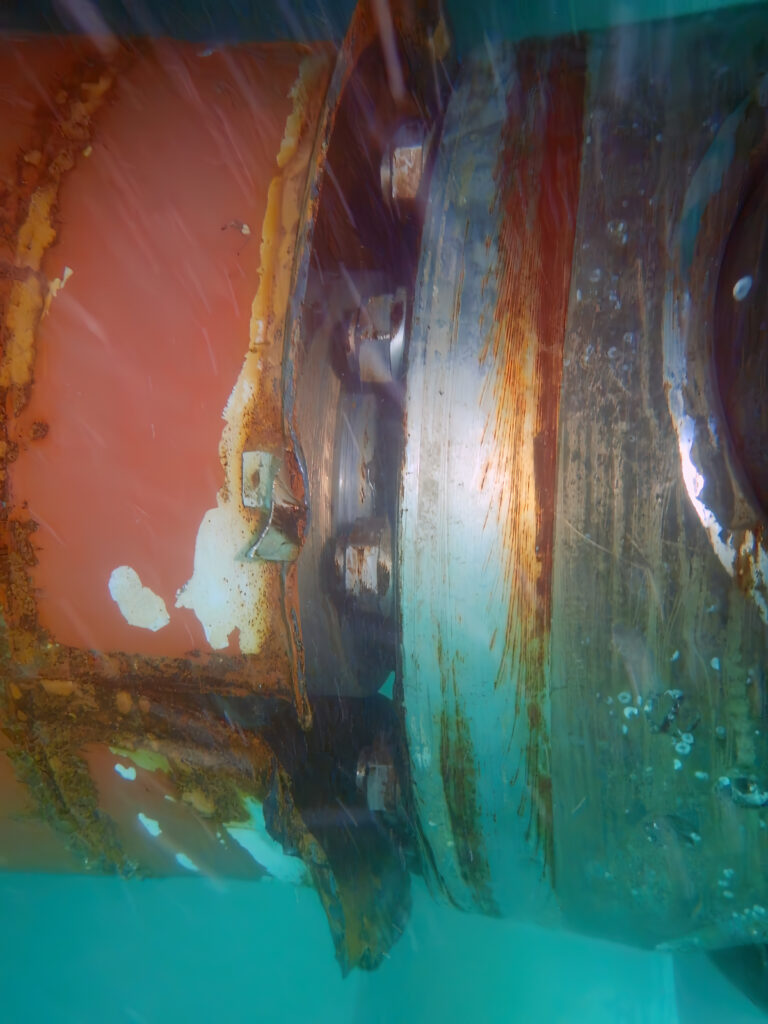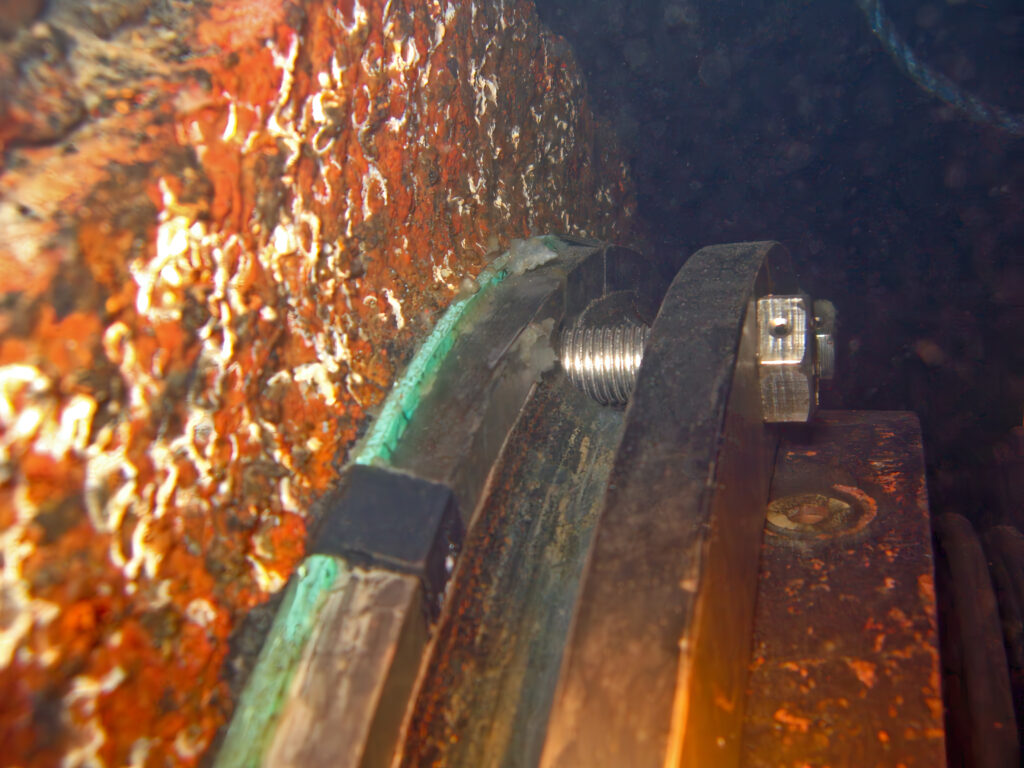For Hydrex’s 50th anniversary we are looking back at the history and a few memorable case studies of each of the services we offer to our customers. This month we are focusing on underwater stern tube seal repairs.
In the summer of 1996, we carried out an underwater face seal replacement on a ro/ro vessel. Face seal replacements had been carried out by our divers in the Antwerp workshop, but now they were able to perform this task while in the water. Since then, we have constantly worked to advance the techniques used for stern tube seal repairs. At the end of 1999 Hydrex started working on injections with lip type stern tube seals. In 2000 we carried out tests for wet bonding on lip type seals. These tests showed that wet bonding could only give an 80% result compared with dry bonding. Instead of giving up on replacing lip type seals underwater, our R&D department developed a procedure which avoids wet bonding but still accomplishes successful underwater seal repairs.
In 2002 the flexible mobdock was further developed so that a similar dry underwater working environment could be created around a stern tube seal assembly to facilitate repair work on the assembly and enable the replacement of damaged seals in-situ. This technique has since been refined and used on numerous stern tube seal repairs around the world. It allows ship owners to keep their vessel sailing, saving precious time and money.
It is not always straightforward to replace seals, because the configuration of the stern tube itself can vary considerably. There can also be complications with the liners, which can be worn down and show ruts. However, all this is routinely handled by our teams on the jobs.
All shaft seal repairs we offer are performed in cooperation with the OEM. We usually supply the equipment, but the owner is free to supply his own OEM seals. We can handle all types of seals from all manufacturers.
Complete renewal of stern tube assembly allows passage through Panama Canal
In 2016 our divers assisted an excavation vessel hemorrhaging oil from a stern tube seal entangled with steel wire to pass safely through the Panama Canal.
The 156-meter long, Dutch-owned vessel was unable to make the canal transit until the propeller shaft seal had been repaired, potentially delaying operations and resulting in financial penalty for the owner.

“The ship needed to pass through the Panama Canal to reach its next destination, but the leak had to be repaired before it was allowed to do so. We immediately flew in a diving team to carry out a fast underwater repair so the vessel could continue,” said Dave Bleyenberg, Tech Services at Hydrex.
“Our team arrived in Balboa, Panama, where the vessel lay at anchorage, and sailed to the ship on a workboat loaded with all the equipment needed for the operation.”
The dive team’s inspection confirmed that steel cable was entwined around the seal, extensively damaging the stern tube assembly. The rope guard – a component designed to prevent ropes and wires from wrapping around the propeller shaft and damaging the seal system – was found to be severely dented, destroying the seal’s split-type housing.

After removing the damaged components, which had already taken in water, our dive team set up a flexible mobdock around the stern tube to create a dry environment in which to carry out the needed repairs.
Since the liner had been severely scuffed by the steel wire, this was the first component to be replaced, after which our diver/technicians bonded four new stern tube seals and installed a new housing. All remaining parts of the stern tube seal assembly were then reinstalled and secured, including a new rope guard. After leak tests confirmed the stern tube seal’s integrity, the mobdock was removed.
“The damage to this vessel’s propeller shaft seal was extensive but we were able to complete repairs in the same time frame as a regular stern tube seal replacement, despite the larger scope of work. In cooperation with our local support base, our teams worked in shifts to keep vessel downtime to the absolute minimum,” said Bleyenberg.

Severe stern tube seal assembly damage repaired underwater in Italy in 2008
When a 38,000 dwt bulk carrier suffered severe damage to its seal assembly we were asked to do the repairs and replace the aft seals using our flexible mobdock technique while the vessel was in Piombino, Italy.
The rope guard was missing from the seal assembly and some of the stern tube flange bolts were seriously damaged, while others had broken off. The flange ring had mostly been scraped away, presumably by the rope guard before it had become completely detached. There was also a gap between the stern tube and the flange.

It was clearly a complicated repair, but our technical department worked out a procedure to carry out the work on-site. Meanwhile, a technical diving team and the flexible mobdock, vital to the repair work, were already mobilized from Antwerp to Piombino.
The gap between the stern tube and the flange was measured and these measurements were used to manufacture a specially designed split ring – the push ring. This was used to push the flange back into position against the stern tube where it was secured with new, longer flange bolts.
With this push ring in place, a distance ring was used to replace the spacer ring in the opening between the stern tube and the flange. At this point the flexible mobdock was installed around the mechanism.

The two water seals were renewed and bonded following standard procedure. The seal assembly was then pushed against the stern tube without the distance ring or the spacer ring to create a new running surface for the seals, and to create the extra space needed for replacing the oil seal, which was subsequently completed.
An overnight leakage test was then executed with positive results and the system was refilled with oil.
Drydocking had initially appeared to be the only option for the shipowner. The stern tube seal assembly had sustained damage that seemed too extensive to repair underwater. Being accustomed to solving such problems, our technical personnel outlined a detailed approach that enabled the diving team to carry out the needed underwater repairs on the seal assembly in the wet before installing our mobdock and replacing the seals.

If ever you need assistance with the underwater part of your vessel, give us a call. We can then tell you if the repair is feasible and start working on its handling.
+32 3 213 53 00
hydrex@hydrex.be
Click on the images below for more case studies.

Underwater repair of leaking seal assembly in Trinidad

Underwater bow thruster removal and reinstallation in Australia

Scrubber overboard pipe repairs in Belgium and the Netherlands

Insert installation in Uruguay prevents loss of contract

Double stern tube seal repair on second vessel in Tasmania confirms customer’s trust




